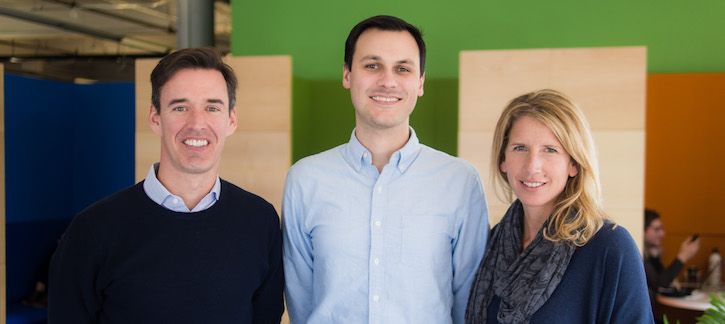- Politics
- Diversity, equity and inclusion
- Financial Decision Making
- Telehealth
- Patient Experience
- Leadership
- Point of Care Tools
- Product Solutions
- Management
- Technology
- Healthcare Transformation
- Data + Technology
- Safer Hospitals
- Business
- Providers in Practice
- Mergers and Acquisitions
- AI & Data Analytics
- Cybersecurity
- Interoperability & EHRs
- Medical Devices
- Pop Health Tech
- Precision Medicine
- Virtual Care
- Health equity
There Are Now 1 Million Medical Professionals Using Doximity
The physician social network now has a wealth of capabilities—and responsibilities—its founders never could've imagined.

Doximity cofounders Jeff Tangney (left), Nate Gross (center), and Shari Buck (right).
In less than 7 years, physician social networking platform Doximity has reached 1 million members, the company announced today. Company co-founder Nate Gross, MD, doesn’t take the number lightly.
“There actually aren’t that many doctors in the country, and so to pass a million clinicians is a pretty big milestone both for us and for medicine in the United States,” he told Healthcare Analytics News™ in an interview today.
And as grandiose as adding “for medicine in the United States” may sound, Doximity has a case to make for that: The platform has unprecedented reach within the industry. Its membership includes over 675,000 physicians, or over 70% of all licensed doctors working in the United States today. It also covers almost half of nurse practitioners and physician assistants, about 90% of 4th year medical students, and a growing slice of the pharmacist community.
Managing such a wide network covering a vital sector of the population brings an inherent sense of obligation, Gross said. Culture, growth, and benefits might land the company on “top workplace” lists, but the co-founder said most of the people in the company have a larger motivation.
“This is the largest aggregation of doctors in the United States, and we know that the healthcare system in the United States needs a lot of help. As one of the groups that can help fix that, we have a responsibility to help do so,” he said.
That sense of obligation reflects in the company’s technology. The only thing doctors have adopted faster than its network are smartphones themselves, Gross cracked, and most of the platform’s traffic comes from mobile devices. Doximity has integrated tools, like its Dialer service that allow doctors to contact patients from their own phones while routing the call through the office (both to protect their own phone number and to contact patients with a recognizable number).
Likewise, the healthcare system at large may struggle mightily with interoperability, Gross pointed out that doctors are able to reach out directly through the platform to colleagues in different health systems when referring patients or seeking information about them. Communication through Doximity is HIPAA-compliant and secure.
It can also be used to inform. The company doesn’t want its news feed to be “another place to watch cat videos,” as Gross puts it. There is more medical research being done than ever, but it can still take 17 years or even decades for the most recent knowledge to disseminate to everyone in the field. In order to curate a news feed that keeps doctors informed of best practices, Doximity has a dedicated team preening through not just new medical research but also the articles that patients may be reading about their own health.
“Theoretically, you can turn that 17-year lag into a 17 minute lag, and that could save a ton of lives,” Gross said, again invoking a sense of responsibility.
And while medical research usually focuses on patient health, the unique cohort Doximity has assembled can provide insights about the other half of the healthcare equation. It can put out internal research—like a recent look at physician language barriers or an upcoming dive into physician compensation nationwide—or it can provide access to its cohort to academic researchers for peer-reviewed articles.
The founders—Gross, Chief Product Officer Shari Buck, and CEO Jeff Tangney—may not have set out to start a company with the capabilities and even responsibilities that Doximity now has.
“There was not a fully detailed roadmap of everything that we would be building today,” Gross said. “But there have been some principles that have always been present. It’s very outcome-oriented social media technology that can be used in the workday. That philosophy has pervaded across everything we’ve built.”
As much credit as he can give to the team behind the technology—all 250 or so of them—Gross believes the true strength of the endeavor lies in the knowledge and insights that the doctors who use Doximity provide every day.
“To draw insights from all the different medical specialties among our members has been more important than any in-house expertise our team has brought to the table,” he said. “We’re nothing without our physician members.” Today, the company can count them in 7 figures.
Healthy Bottom Line: The Trouble With SDOH Programs and the Secret to Improving Them
September 28th 2021Several problems exist with current programs that address social determinants of health (SDOH); however, a new social model aims to combat these issues and improve the programs’ effectiveness.
